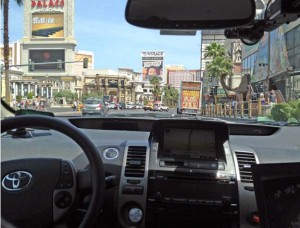The first driverless cars could begin to roll into showrooms by 2025 – if not sooner — a panel of experts agreed during the annual convention of automotive engineers in Detroit.
And many of the technologies that will permit autonomous driving will become commonplace even sooner. Indeed, most major carmakers already offer automated parking systems and radar-guided cruise control technology that allows a vehicle to hold with the flow of traffic, even if it comes to a complete stop.
But one of the big questions is whether the litigious U.S. legal system will prevent the widespread use of autonomous vehicles even though the nation’s top auto safety official has suggested self-driving cars could reduce by “thousands” the annual American highway death toll.
“Connected and autonomous vehicles will be the car of the future — cars that don’t crash for drivers who live in a sea of distraction,” proclaimed Peter Sweatman, director of the University of Michigan Transportation Research Institute.
Speaking at the annual Society of Automotive Engineers World Congress, Sweatman stressed that, “Driving is not something humans are very good at.” A look at the data proves his point. At least 10% of the fatalities on U.S. roads last year involved distracted driving. And some form of human error is considered the sole factor in 76% of vehicle crashes.
Proponents insist that autonomous vehicles, with their cameras, laser and radar sensors, will be able to traverse the nation’s highways without distraction and ultimately outperform even the best human drivers.
David Strickland, the administrator of the National Highway Traffic Safety Administration, recently estimated such technology could save “thousands of lives” annually. He has launched a research project that should lead NHTSA to begin writing rules for autonomous vehicles within the next two to three years.
Several states, starting with Nevada, have already enacted their own guidelines and others, including Michigan, plan to follow.
During a session at the SAE World Congress, various speakers outlined their ambitions – and concerns – about autonomous technology.
They noted that various technologies are already becoming commonplace, especially in high-line vehicles. The latest active cruise control system on the new Mercedes-Benz E-Class not only can match the pace of traffic but bring a vehicle to a complete stop and then start up again when traffic begins moving again. Volvo has updated its City Safety technology so that it can apply the brakes automatically if a pedestrian or bicyclist moves into the V60 wagon’s path.
There are a number of driverless prototype vehicles now plying the roads as part of test programs run by various automakers, automotive suppliers and even Google, which has decided to take a lead in the technology.
The Silicon Valley firm has suggested it could be ready for prime time by as early as 2020, though during the SAE panel, Christian Schumacher, the head of Advanced Driver Assistance Systems for Continental Automotive, said that, “2025 is the time frame where we see cars driving themselves.”
Ironically, while proponents see a bright future for driverless technology, anticipating a sharp decline in vehicle collisions, injuries and fatalities, they also warn that the tolerance for error will be small.
“If a driverless car has just one accident, it will be a whole new discussion,” warned Schumacher.
In the highly litigious U.S. legal system, plaintiffs’ attorneys are certain to zero in on any crash involving an autonomous vehicle. That, some observers caution, could force the auto industry to hold back on driverless technology, at least in the States, while introducing it in other parts of the world where they might spend less time defending themselves in court.

